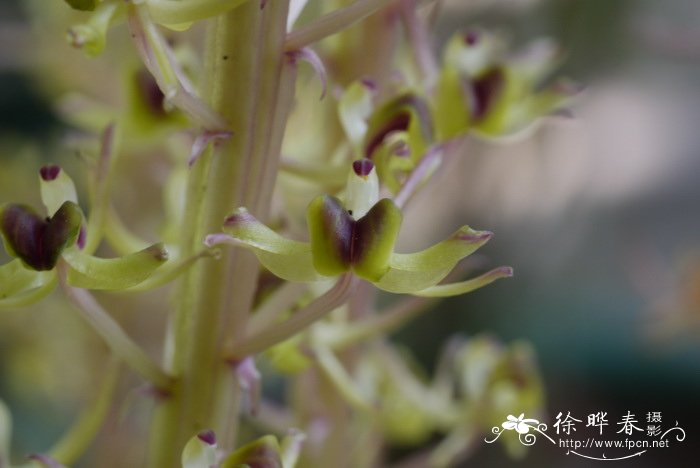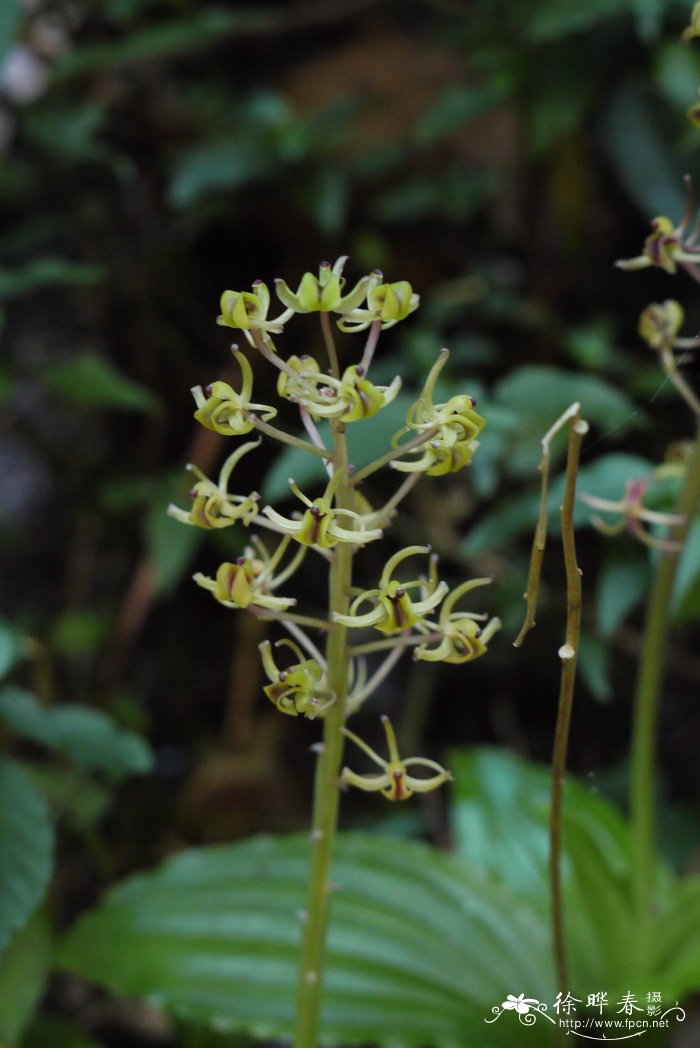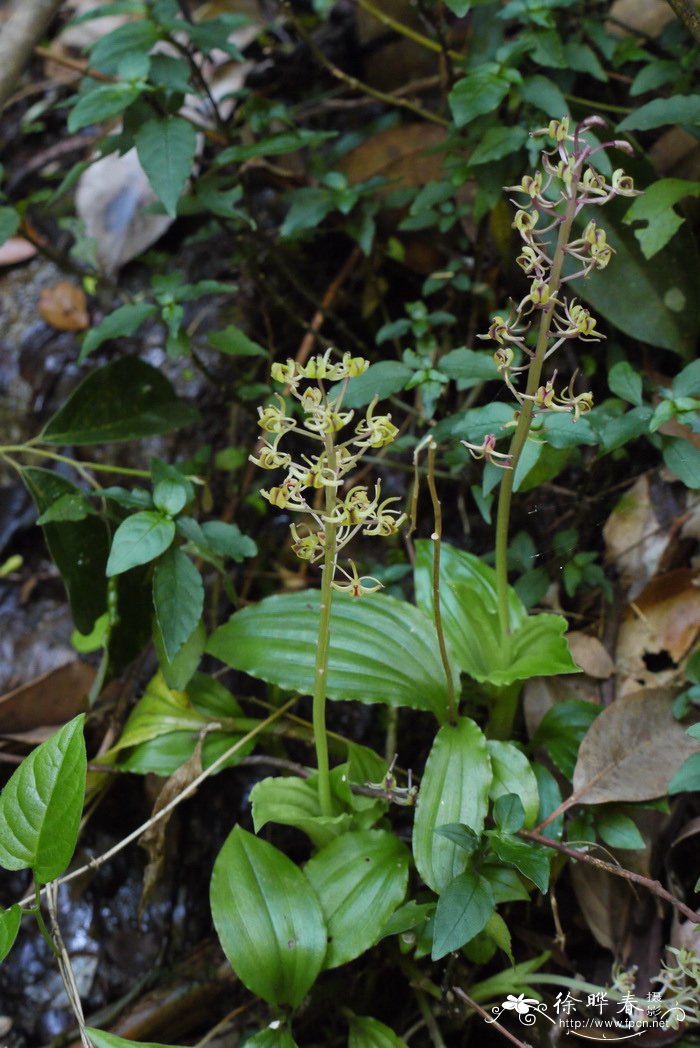见血清 Liparis elata
中文名(Chinese Name):见血清
学名(Scientific Name):Liparis elata Lindl.
英文名(English Common Name):pantropical widelip orchid
别名(Chinese Common Name):
异名(Synonym):Liparis bituberculata var. formosana Ridl. Malaxis nervosa (Thunb. ex A. Murray) Sw. Liparis formosana f. aureo-variegata Nakaj. Liparis formosana Rchb. f. Liparis khasiana (Hook. f.) T. Tang et F. T. Wang Liparis bicallosa (D. Don) Schltr. Liparis bituberculata var. khasiana Hook. f. Liparis nervosa var. formosana (Rchb. f.) Hiroe Liparis bambusaefolia Makino Liparis shaoshunia S. S. Ying Ophrys nervosa Thunb. ex A. Murray Bletia bicallosa D. Don Sturmia nervosa (Thunb.) Rchb.f. Iebine nervosa (Thunb.) Raf. Leptorkis nervosa (Thunb.) Kuntze Diteilis nervosa (Thunb.) M.A.Clem. & D.L.Jones Cymbidium nervosum (Thunb.) Sw. Leptorchis bituberculata (Lindl.) Kuntze Leptorchis eggersii (Rchb. f.) Kuntze Leptorchis elata (Lindl.) Kuntze Leptorchis guineensis (Lindl.) Kuntze Leptorchis kappleri (Rchb. f.) Kuntze Leptorchis nervosa (Lindl.) Kuntze Leptorchis odontostoma (Rchb. f.) Kuntze Leptorchis odorata (Lindl.) Kuntze Leptorchis olivacea (Lindl.) Kuntze
科属(Family & Genus):兰科(Orchidaceae)羊耳蒜属
形态特征(Description):地生草本。茎(或假鳞茎)圆柱状,肥厚,肉质,有数节,长2-8(-10)厘米,直径5-7(-10)毫米,通常包藏于叶鞘之内,上部有时裸露。叶(2-) 3-5枚,卵形至卵状椭圆形,膜质或草质,长5-11(-16)厘米,宽3-5(-8)厘米,先端近渐尖,全缘,基部收狭并下延成鞘状柄,无关节;鞘状柄长2-3(-5)厘米,大部分抱茎。花葶发自茎顶端,长10-20 (-25)厘米;总状花序通常具数朵至10余朵花,罕有花更多;花序轴有时具很狭的翅;花苞片很小,三角形,长约1毫米,极少能达2毫米;花梗和子房长8-16毫米;花紫色;中萼片线形或宽线形,长8-10毫米,宽1.5-2毫米,先端钝,边缘外卷,具不明显的3脉;侧萼片狭卵状长圆形,稍斜歪,长6-7毫米,宽3-3.5毫米,先端钝,亦具3脉;花瓣丝状,长7-8毫米,宽约0.5毫米,亦具3脉;唇瓣长圆状倒卵形,长约6毫米,宽4.5-5毫米,先端截形并微凹,基部收狭并具2个近长圆形的胼胝体;蕊柱较粗壮,长4-5毫米,上部两侧有狭翅。蒴果倒卵状长圆形或狭椭圆形,长约1.5厘米,宽约6毫米;果梗长4-7毫米。花期2-7月,果期10月。
分布(Distribution):产华东、华中、华南及西南地区,生于海拔1000~2100米林下、溪谷旁、草丛阴处或岩石覆土上。广泛分布于全世界热带与亚热带地区。
用途(Use):
引自中国植物志英文版:FOC Vol. 25 Page 212, 218, 219
Liparis nervosa (Thunberg) Lindley, Gen. Sp. Orchid. Pl. 26. 1830.
见血青 jian xue qing| Orchidaceae | Liparis
Ophrys nervosa Thunberg in Murray, Syst. Veg., ed. 14, 814. 1784; Bletia bicallosa D. Don; Epidendrum nervosum (Thunberg) Thunberg; Liparis bambusifolia Makino; L. bicallosa (D. Don) Schlechter; Malaxis nervosa (Thunberg) Swartz; Sturmia nervosa (Thunberg) H. G. Reichenbach.
Herbs, terrestrial. Stem cylindric, 2-8(-10) cm, 5-7(-10) mm in diam., thick, fleshy, with many nodes, usually ± enclosed by sheaths, upper part sometimes naked. Leaves 3-6; petiole sheathlike, 2-3(-5) cm, amplexicaul, long, not articulate; blade ovate to ovate-elliptic, 5-11(-16) × 3-5(-8) cm, membranous or herbaceous, base contracted and decurrent into petiole, margin entire, apex subacuminate. Inflorescence subterminal, 10-20(-25) cm; rachis several to 10-flowered, sometimes with very narrow wing; floral bracts deltoid, 1(-2) mm. Flowers purple; pedicel and ovary 8-16 mm. Dorsal sepal linear or broadly linear, 8-10 × 1.5-2 mm, inconspicuously 3-veined, margin revolute, apex obtuse; lateral sepals narrowly ovate-oblong, slightly oblique, 6-7 × 3-3.5 mm, 3-veined, apex obtuse. Petals reflexed, filiform, 7-8 × ca. 0.5 mm, 1-veined; lip oblong-obovate, 6-6.5 × 4.5-5 mm, base narrowed and with 2 suboblong calli, apex truncate and emarginate. Column 4-5 mm, rather stout, upper part distinctly or indistinctly with narrow wings. Capsule obovate-oblong or narrowly elliptic, ca. 1.5 cm × 6 mm; fruiting pedicel 4-7 mm. Fl. Feb-Jul, fr. Oct. 2n = 36, 40, 42.
Forests, shaded places in grasslands or soil-covered rocks along streamsides; 1000-2100 m. N Fujian, Guangdong, Guangxi, Guizhou, Hubei, S Hunan, Jiangxi, S Sichuan, Taiwan, SE Xizang, Yunnan, S Zhejiang [widespread in Old and New World tropics].
Liparis nervosa is represented in China by the typical variety; L. nervosa var. khasiana (J. D. Hooker) P. K. Sarkar is restricted to NE India and is distinguished by having only two or three leaves and petals that are neither reflexed nor twisted.


 (责任编辑:徐晔春)
(责任编辑:徐晔春)
学名(Scientific Name):Liparis elata Lindl.
英文名(English Common Name):pantropical widelip orchid
别名(Chinese Common Name):
异名(Synonym):Liparis bituberculata var. formosana Ridl. Malaxis nervosa (Thunb. ex A. Murray) Sw. Liparis formosana f. aureo-variegata Nakaj. Liparis formosana Rchb. f. Liparis khasiana (Hook. f.) T. Tang et F. T. Wang Liparis bicallosa (D. Don) Schltr. Liparis bituberculata var. khasiana Hook. f. Liparis nervosa var. formosana (Rchb. f.) Hiroe Liparis bambusaefolia Makino Liparis shaoshunia S. S. Ying Ophrys nervosa Thunb. ex A. Murray Bletia bicallosa D. Don Sturmia nervosa (Thunb.) Rchb.f. Iebine nervosa (Thunb.) Raf. Leptorkis nervosa (Thunb.) Kuntze Diteilis nervosa (Thunb.) M.A.Clem. & D.L.Jones Cymbidium nervosum (Thunb.) Sw. Leptorchis bituberculata (Lindl.) Kuntze Leptorchis eggersii (Rchb. f.) Kuntze Leptorchis elata (Lindl.) Kuntze Leptorchis guineensis (Lindl.) Kuntze Leptorchis kappleri (Rchb. f.) Kuntze Leptorchis nervosa (Lindl.) Kuntze Leptorchis odontostoma (Rchb. f.) Kuntze Leptorchis odorata (Lindl.) Kuntze Leptorchis olivacea (Lindl.) Kuntze
科属(Family & Genus):兰科(Orchidaceae)羊耳蒜属
形态特征(Description):地生草本。茎(或假鳞茎)圆柱状,肥厚,肉质,有数节,长2-8(-10)厘米,直径5-7(-10)毫米,通常包藏于叶鞘之内,上部有时裸露。叶(2-) 3-5枚,卵形至卵状椭圆形,膜质或草质,长5-11(-16)厘米,宽3-5(-8)厘米,先端近渐尖,全缘,基部收狭并下延成鞘状柄,无关节;鞘状柄长2-3(-5)厘米,大部分抱茎。花葶发自茎顶端,长10-20 (-25)厘米;总状花序通常具数朵至10余朵花,罕有花更多;花序轴有时具很狭的翅;花苞片很小,三角形,长约1毫米,极少能达2毫米;花梗和子房长8-16毫米;花紫色;中萼片线形或宽线形,长8-10毫米,宽1.5-2毫米,先端钝,边缘外卷,具不明显的3脉;侧萼片狭卵状长圆形,稍斜歪,长6-7毫米,宽3-3.5毫米,先端钝,亦具3脉;花瓣丝状,长7-8毫米,宽约0.5毫米,亦具3脉;唇瓣长圆状倒卵形,长约6毫米,宽4.5-5毫米,先端截形并微凹,基部收狭并具2个近长圆形的胼胝体;蕊柱较粗壮,长4-5毫米,上部两侧有狭翅。蒴果倒卵状长圆形或狭椭圆形,长约1.5厘米,宽约6毫米;果梗长4-7毫米。花期2-7月,果期10月。
分布(Distribution):产华东、华中、华南及西南地区,生于海拔1000~2100米林下、溪谷旁、草丛阴处或岩石覆土上。广泛分布于全世界热带与亚热带地区。
用途(Use):
引自中国植物志英文版:FOC Vol. 25 Page 212, 218, 219
Liparis nervosa (Thunberg) Lindley, Gen. Sp. Orchid. Pl. 26. 1830.
见血青 jian xue qing| Orchidaceae | Liparis
Ophrys nervosa Thunberg in Murray, Syst. Veg., ed. 14, 814. 1784; Bletia bicallosa D. Don; Epidendrum nervosum (Thunberg) Thunberg; Liparis bambusifolia Makino; L. bicallosa (D. Don) Schlechter; Malaxis nervosa (Thunberg) Swartz; Sturmia nervosa (Thunberg) H. G. Reichenbach.
Herbs, terrestrial. Stem cylindric, 2-8(-10) cm, 5-7(-10) mm in diam., thick, fleshy, with many nodes, usually ± enclosed by sheaths, upper part sometimes naked. Leaves 3-6; petiole sheathlike, 2-3(-5) cm, amplexicaul, long, not articulate; blade ovate to ovate-elliptic, 5-11(-16) × 3-5(-8) cm, membranous or herbaceous, base contracted and decurrent into petiole, margin entire, apex subacuminate. Inflorescence subterminal, 10-20(-25) cm; rachis several to 10-flowered, sometimes with very narrow wing; floral bracts deltoid, 1(-2) mm. Flowers purple; pedicel and ovary 8-16 mm. Dorsal sepal linear or broadly linear, 8-10 × 1.5-2 mm, inconspicuously 3-veined, margin revolute, apex obtuse; lateral sepals narrowly ovate-oblong, slightly oblique, 6-7 × 3-3.5 mm, 3-veined, apex obtuse. Petals reflexed, filiform, 7-8 × ca. 0.5 mm, 1-veined; lip oblong-obovate, 6-6.5 × 4.5-5 mm, base narrowed and with 2 suboblong calli, apex truncate and emarginate. Column 4-5 mm, rather stout, upper part distinctly or indistinctly with narrow wings. Capsule obovate-oblong or narrowly elliptic, ca. 1.5 cm × 6 mm; fruiting pedicel 4-7 mm. Fl. Feb-Jul, fr. Oct. 2n = 36, 40, 42.
Forests, shaded places in grasslands or soil-covered rocks along streamsides; 1000-2100 m. N Fujian, Guangdong, Guangxi, Guizhou, Hubei, S Hunan, Jiangxi, S Sichuan, Taiwan, SE Xizang, Yunnan, S Zhejiang [widespread in Old and New World tropics].
Liparis nervosa is represented in China by the typical variety; L. nervosa var. khasiana (J. D. Hooker) P. K. Sarkar is restricted to NE India and is distinguished by having only two or three leaves and petals that are neither reflexed nor twisted.
踩一下[2]

顶一下[3]